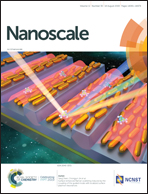Silicon nitride nanopore created by dielectric breakdown with a divalent cation: deceleration of translocation speed and identification of single nucleotides†
Abstract
Nanopore DNA sequencing with a solid-state nanopore requires deceleration of the ultrafast translocation speed of single-stranded DNA (ssDNA). We report an unexpected phenomenon: controlled dielectric breakdown (CBD) with a divalent metal cation, especially Ca2+, provides a silicon nitride nanopore with the ability to decelerate ssDNA speed to 100 μs per base even after solution replacement. This speed is two orders of magnitude slower than that for CBD with a conventional monovalent metal cation. Temperature dependence experiments revealed that the enthalpic barrier for a nanopore created via CBD with Ca2+ is 25–30kBT, comparable to that of a biological nanopore. The slowing effect originates from the strong interaction between ssDNA and divalent cations, which were coated on the sidewall of the nanopore during the CBD process. In addition, we found that the nanopore created via CBD with Ca2+ can decelerate the speed of even single-nucleotide monomers, dNMPs, to 0.1–10 ms per base. The four single nucleotides could be statistically identified according to their blockade currents. Our approach is simple and practical because it simultaneously allows nanopore fabrication, ssDNA deceleration and the identification of nucleotide monomers.



 Please wait while we load your content...
Please wait while we load your content...